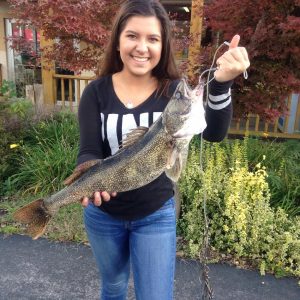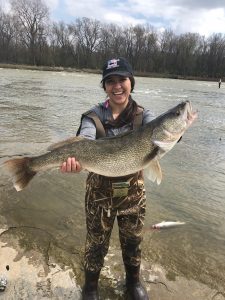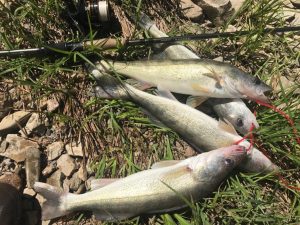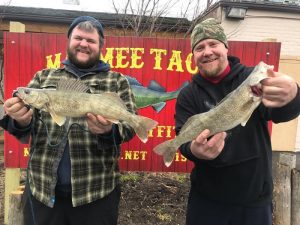Walleye is a freshwater fish native to most of Canada and to the Northern United States. In parts of its range in northern Us, the walleye is known as a pike or pickerel, even though the fish is not related to the true pikes, Walleyes show a fair amount of variation across watersheds. In general, fish within a watershed are quite similar and are genetically distinct from those of nearby watersheds. The species has been artificially propagated for over a century and has been planted on top of existing populations or introduced into waters naturally devoid of the species, sometimes reducing the overall genetic distinctiveness of populations.The common name, “walleye”, comes from the fact that the fish’s eyes point outward as if looking at the walls. This externally facing orientation of the eyes gives anglers an advantage in the dark because there is a certain eyeshine given off by the eye of the walleye in the dark, similar to that of lions and other night dwelling animals. This “eyeshine” is the result of a light-gathering layer in the eyes called the
The common name, “walleye”, comes from the fact that the fish’s eyes point outward as if looking at the walls. This externally facing orientation of the eyes gives anglers an advantage in the dark because there is a certain eyeshine given off by the eye of the walleye in the dark, similar to that of lions and other night dwelling animals. This “eyeshine” is the result of a light-gathering layer in the eyes called the tapetum lucidum, which allows the fish to see well in low-light conditions. In fact, many anglers look for walleyes at night since this is when major feeding patterns occur. The fish’s eyes also allow them to see well in turbid waters (stained or rough, breaking waters), which gives them an advantage over their prey. Thus, walleye anglers will commonly look for locations where there is a good “walleye chop” (i.e., rough water). This excellent vision also allows the fish to populate the deeper regions in a lake, and they can often be found in deeper water, particularly during the warmest part of the summer.
Walleyes are largely olive and gold in color. The dorsal side of a walleye is olive, grading into a golden hue on the flanks. The olive/gold pattern is broken up by five darker saddles that extend to the upper sides. The color shades of white on the belly. The mouth of a walleye is large and is armed with many sharp teeth. Walleyes are distinguished from their close cousin the sauger by the white coloration on the lower lobe of the caudal fin which is absent on the sauger. In addition, the two dorsals and the caudal fin of the sauger are marked with distinctive rows of black dots which are absent from or indistinct on the same fins of walleyes.
“Walleye chop” is a term used by walleye anglers for rough water typically with winds of 5 to 15 mph, and is one of the indicators for good walleye fishing due to the walleye’s increased feeding activity during such conditions. In sunny conditions walleye move in schools to deeper shady areas, so when one walleye is caught there are usually other walleye feedings in the same location These schools usually contain walleye of similar age and size.Walleyes grow to about 31 in length and weigh up to about 20 lb. The rate depends partly on where in their range they occur, with southern populations often growing faster and larger. In general, females grow larger than males. Walleyes may live for decades; the maximum recorded age is 29 years. In heavily fished populations, however, few walleye older than five or six years of age are encountered. In North America, where they are highly prized, their typical size when caught is on the order of 15 to 20 in, substantially below their potential size.Since walleyes have excellent visual acuity under low illumination levels, they tend to feed more extensively at dawn and dusk, on cloudy or overcast days and under choppy conditions when light penetration into the water column is disrupted. Although anglers interpret this as light avoidance, it is merely an expression of the walleye’s competitive advantage over its prey under those conditions. Similarly, in darkly stained or turbid waters, walleye tend to feed throughout the day.
In most of the species’ range, male walleyes mature sexually between three and four years of age. Females normally mature about a year later. Adults migrate to tributary streams such as the Maumee River in late winter or early spring to lay eggs over gravel and rock, although there are open water reef or shoal spawning strains as well. Some populations are known to spawn on sand or vegetation. Spawning occurs at water temperatures of 43 to 50 °F. A large female can lay up to 500,000 eggs, and no care is given by the parents to the eggs or fry. The eggs are slightly adhesive and fall into spaces between rocks. The incubation period for the embryos is temperature-dependent, but generally, lasts from 12 to 30 days. After hatching, the free-swimming embryo spends about a week absorbing a relatively small amount of yolk. Once the yolk has been fully absorbed, the young walleye begins to feed on invertebrates, such as fly larvæ and zooplankton  After 40 to 60 days, juvenile walleyes become bait fish carnivores. From there on both juvenile and adult walleyes eat fish almost exclusively moving onto bars and shoals at night to feed. Walleye also feed heavily on crayfish, minnows, and leeches.
Fishing Techniques
Tackle
Most anglers use spinning tackle, but bait cast will work just as
well. Preferred rod actions and lengths vary from 5′ 6” to 6′ in medium to medium-heavy. A longer rod 6’6” – 7′ can give you more casting distance and quicker hook set. When the river level is low, fishing with medium-light tackle can be fun and more productive. Line weight 8 lb to 10 lb test is most popular.
Wading in the river can be quite cold. Wearing a good pair of neoprene waders will make all the difference. It’s a good idea to bring along an extra set of clothes in case you trip and fall in.
SHOP OUR WALLEYE RUN ESSENTIALS HERE
Lures
With the single hook law in effect during March and April you are limited to what you can use. The most popular lure choice is a Carolina Rig with a floating jig and grub combo. Using smaller lead head jigs with a single tail grub is also productive. On the Carolina rig leaders are 4-5 feet. Occasionally shorter leaders will do the job. Favorite colors are white, clear chartreuse sparkle, chartreuse, hot pink, and motor oil with gold flake.
Technique
It is my opinion that the lighter weight you use the better you are going to do. Keep in mind that you must keep in contact with the bottom. This is very important being walleyes, for the most part, are on the bottom. I prefer a little lighter tackle than most. During high water, I will use a 6′ medium action rod with 8 lb test. Thinner line diameter will cut the current better allowing my jig to get to the bottom easier. During low water, I use a 6′ 6” medium-light action rod with 6 to 8 lb test. When a walleye draws a lighter bait into its mouth it will result in a better hook up. Using no stretch lines may result in the opposite, not letting the jig go in its mouth as far. People say with a no stretch line you can feel the bottom and your bites better. This is true, but the fish can feel
During low water, I use a 6′ 6” medium-light action rod with 8-10 lb test. When a walleye draws a lighter bait into its mouth it will result in a better hook up. Using no stretch lines may result in the opposite, not letting the jig go in its mouth as far. People say with a no stretch line you can feel the bottom and your bites better. This is true, but the fish can feel lure resistance sooner ejecting your lure from its mouth. No stretch lines (super-braids) also can create a nasty snag in the river bottom if you break off.
As you’re standing in the river facing cross current cast your rig up stream just slightly allowing your bait to hit bottom directly in front of you. If it hits the river bottom upstream of it will result in an instant snag. As your jig hits bottom in front of you let the current carry it down stream keeping it in contact with the bottom. Jig your rod up slightly as your bait comes in contact with bigger feeling rocks. Reeling in only to keep the slack out of your line. Your rod is like your eyes to the bottom. As your drifting your bait filling it bounce off the bottom, and then lose contact with the bottom, you have just drifted over a hole. When you feel this happening reach forward with your rod to allow your jig to fall into the hole. Key in on these types of depressions, working them repeatedly. As your jig starts to swing in toward shore, jig it slowly back to you, keeping in contact with the bottom.
Bites can be very light at times. Developing the feel for those light bites will make you a successful angler. Watch your rod tip for bites. You won’t always feel them. Bites can be very light. If your rod tip goes down a little farther than the normal bouncing from the bottom, it could be a bite. When in doubt, set the hook.
Another area where you will find fish is current breaks. Look for where slow current lays next to fast water. Fish will come just out of fast water and rest in the slower current. One more tip I can give you is during high water a lot fish will be close to the bank out of the fast current.
Jig size will depend on how high and fast the current is. I will normally start with a 1/4 oz jig. If I’m dragging the bottom too much and losing too many jigs, I will go lighter. Get used to losing jigs, it’s part of fishing the river. But if I’m not in contact with the bottom enough, I prefer to add split shot 15” or so up my line rather than going to a heavier jig. In this case, I might have a total weight of 3/8 oz or more, whatever it takes to get that right feel on the bottom. Adjust your Carolina rig the same way.
When using a Carolina rig you work it basically the same. To tie a Carolina rig, slide an egg sinker or a worm weight up to your main line, then tie a barrel swivel to the end of it to act as a stopper. Tie a leader line 18” – 24” on to the other end of your barrel swivel, then your floating jig head to the end of your leader. Some anglers will use the next size test smaller from their main line for their leader line so that when you snag the bottom you will only loose your leader and jig.
Where to fish
During the walleye run the vast majority of the fishing takes place along a four-mile stretch of river. Starting from Orleans Park located in the town of Perrysburg, upstream to Jerome Rd. at Side Cut Metro Park. Let’s start at the lower end of the river. Orleans Park is good during high water (583 ft and higher above sea level) from below the Maumee-Perrysburg bridge, downstream to the boat ramp. During really high water fishing directly downstream from the Orleans, the boat ramp is best. The reason this area is good during high water is the slower current due to the river being wider at that point. The White St. access can be productive during high water and is one of the most popular areas for bank fishing. The White St. access is located across the river from Orleans park on the Maumee side of the river and is good at all water levels. During high water Side Cut Park would have to fast of current and dangerous to wade. As the water recedes fish will start working their way up the river. Upstream from Orleans park on the Perrysburg side of the river is Fort Meigs.
This park is good during slightly high water to near low water. Wading directly in front of the parking lot is a good place to fish. Across the river from Fort Meigs is the Tow Path which is part of Side Cut Park. This area is good for slightly high water to low water. Mid-way from the Maumee-Perrysburg bridge to the downstream end of Blue Grass Island and is another good area to fish from the bank or wading. This whole stretch of river is known as the Tow Path and is good for wading (NOT DURING HIGH WATER). Upstream from the Tow Path is Blue Grass Island, a very popular area to fish. To fish the island you must wade across a small part of the river (581 feet above sea level is safe to cross over to the island ). There are two area’s to cross. One crossing is located at Island View parking lot. The other is located at the upstream end of the island. Wading across is easy with only a few bigger rocks that may cause tripping. Take your time crossing and you will find it easy.
Upstream from the Tow Path is Blue Grass Island, a very popular area to fish. To fish the island you must wade across a small part of the river (581 feet above sea level is safe to cross over to the island ). There are two area’s to cross. One crossing is located at Island View parking lot. The other is located at the upstream end of the island. Wading across is easy with only a few bigger rocks that may cause tripping. Take your time crossing and you will find it easy.
After crossing the river you will take one of the paths to the main river. There you will find many good places to fish. You must keep track of the river level while fishing off the island. If the water rises while you’re fishing you may not be able to cross back safely. This is no laughing matter.
If you get caught in this situation don’t put your life at risk. Wait for help.
Floating down the river and not being able to touch bottom is terrifying and deadly with low water temperatures. Hypothermia can set in less than five minutes. If high water is expected, the park rangers will post a danger sign at both crossings. If the fire department is called out and you are rescued, you will also receive a fine. Fishing Blue Grass is great, but only during low water (581 – ) for obvious reasons. Use good judgment. Directly across from Blue Grass Island you will see another mob of fishermen. They are fishing at Buttonwood. Buttonwood is a very popular access on the Perrysburg side of the river. There is plenty of parking and there is also a campground (primitive) run by Perrysburg Twp. At this access, you will find lots of room to fish. Buttonwood is good fishing from low to normal water levels. Upstream from Blue Grass Island, in Side Cut Park, all the way to Jerome Rd. is excellent fishing from low water to normal water levels.
Fishing Blue Grass is great, but only during low water (582 ft or lower ) for obvious reasons. Use good judgment. Directly across from Blue Grass Island you will see another mob of fishermen. They are fishing at Buttonwood. Buttonwood is a very popular access on the Perrysburg side of the river. There is plenty of parking and there is also a campground (primitive) run by Perrysburg Twp. At this access, you will find lots of room to fish. Buttonwood is good fishing from low to normal water levels. Upstream from Blue Grass Island, in Side Cut Park, all the way to Jerome Rd. is excellent fishing from low water to normal water levels.




